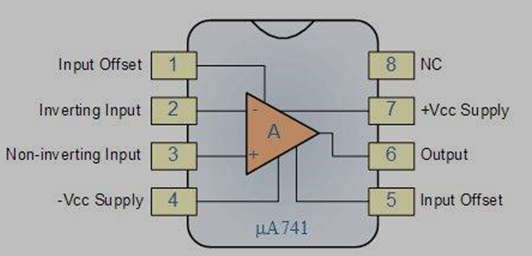- The analog circuit component is known as an operational amplifier (op amp) converts a differential voltage input into a single-ended voltage output. Op amps typically feature three terminals: a low-impedance output port and two high-impedance inputs.
What Is An Operational Amplifier?
- The simplest definition of an operational amplifier is a linear Integrated Circuit (IC) with numerous terminals. Op-amps are voltage amplifiers that are made to be utilized with external feedback elements like resistors and capacitors connected between their output and input terminals. It is an electrical voltage amplifier with high gain that typically has a single-ended output and a differential input. Due to its widespread use in a wide range of consumer, industrial, and scientific devices, op-amps are among the most commonly utilized electronic devices in use today.
Construction of Op-Amp
- The inner schematic of a typical operational amplifier looks like this
![]()
- Inverting input terminals are denoted by a (-) sign, while non-inverting input terminals are denoted by a (+) sign.
- The positive and negative terminals of a DC voltage source are linked to the V+ and V power supply terminals, respectively. The common terminal of the V+ and V must be linked to a ground or reference point to prevent the op-amp from being damaged by twice the supply voltage.
Types of Op-Amps
The fundamental component of both linear and non-linear analog systems, an op-amp has a wide range of uses. Among the several op-amp kinds are
- A circuit that amplifies the difference between two signals is known as a differential amplifier.
- The instrumentation amplifier typically consists of three op-amps and amplifies a transducer’s output (consisting of measured physical quantities).
- Similar to an instrumentation amplifier but with tolerance for common-mode voltages is the isolation amplifier (that destroys an ordinary op-amp).
- A resistive feedback network with one or more op-amps is typically used to create negative-feedback amplifiers.
- Power amplifiers to boost weak signals coming from an antenna or microphone as an input source.
Op-Amp Operation
- An op-amp, also known as differential input voltage, should ideally simply amplify the voltage difference between the two. The equation: gives the op-Vout amp’s output voltage.
- V+ – V- = AOL in Vout
- where AOL denotes the amplifier’s open-loop gain.
- The output signal of a linear operational amplifier is the input signal’s value multiplied by the amplifier’s gain (A), also known as gain.
Op-Amp Parameters
- The voltage that must be placed between an op-input amp’s terminals to cancel out the output is known as the input offset voltage.
- The algebraic difference between the currents flowing into the (-) and (+) inputs is known as the input offset current.
- The average current flowing into an op-(-) amp’s input and (+) input terminals is known as the input bias current.

- As viewed at either of the input terminals with the other terminal connected to the ground, the input resistance is the differential input resistance.
- The equivalent capacitance that may be measured at either of the input terminals with the other terminal connected to the ground is known as the input capacitance.
- Slew rate is the maximum rate at which the output voltage changes as a result of a step input voltage. Higher DC supply voltage and closed loop gain both increases the slew rate. It is also a function of temperature and typically gets smaller as the temperature rises.
Applications of Op-Amp
- The fundamental component of both linear and non-linear analog systems, an op-amp has a wide range of uses.
The output signal in linear circuits varies linearly with the input signal. Examples of linear applications include
- Voltage to Current Adder Subtractor Converter (Transconductance Amplifier).
- Converter from Current to Voltage (Transresistance Amplifier).
- amplification equipment.
- power booster.
These circuits belong to a different category with highly nonlinear input to output characteristics
- Rectifier
- Peak finder
- Clipper \Clamper
- Circuit for sample and hold
- amplifying using log and antilog
- Divider and multiplier Comparator
